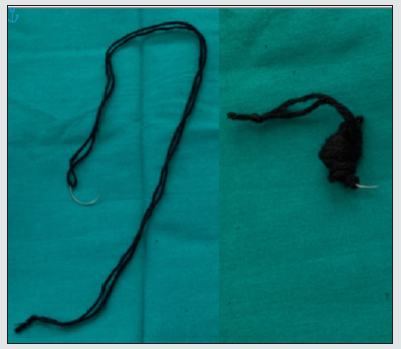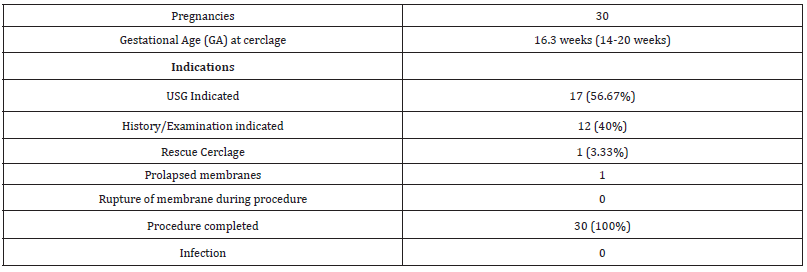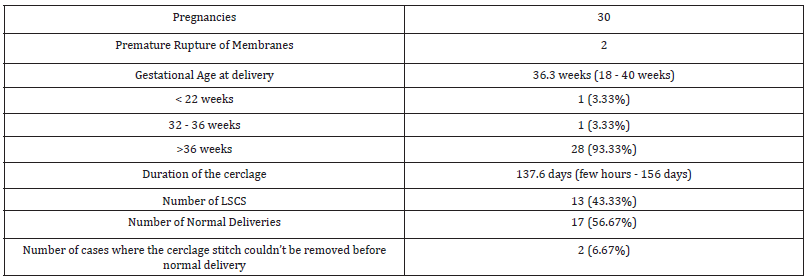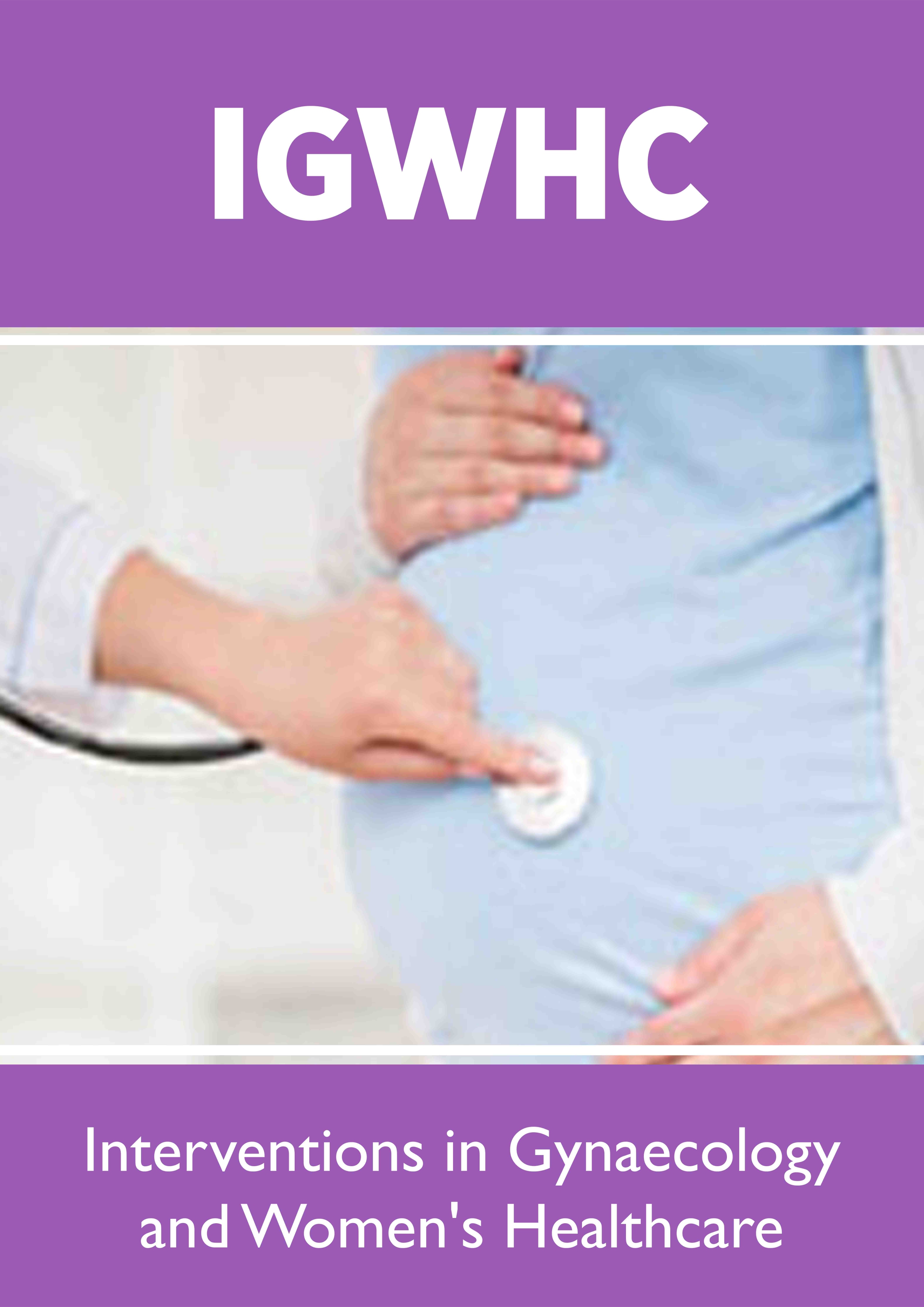
Lupine Publishers Group
Lupine Publishers
Menu
ISSN: 2637-4544
Research Article(ISSN: 2637-4544) 
Ranjana’s Indigenous Suture Material for McDonald’s Cervical Cerclage Volume 4 - Issue 3
Ranjana Khanna, Parul Gupta* and Vikram Khanna
- Department of OBGY, Ranjana Hospital, Prayagraj, India
Received:June 28, 2021Published: July 7, 2021
Corresponding author:Parul Gupta, Department of OBGY, Ranjana Hospital, Prayagraj, India
DOI: 10.32474/IGWHC.2021.04.000195
Abstract
Introduction: Cervical cerclage has been advocated in cases of ‘cervical incompetence’. There is very little evidence on the material to be used for cerclage. Here we have used nylon wool over semicircular needle for cervical cerclage.
Material and Methods: 30 patients were included in the study. After a written informed consent, the patient was then taken for cervical cerclage suture application. The material used was dark colored nylon wool. The primary outcome was live birth rate of the baby where as the secondary outcome parameters included period of gestation at delivery, mode of delivery, length of hospitalization of the baby, NICU if required, requirement of another cerclage in subsequent pregnancies and the timing of removal of cerclage.
Results: Out of the 30 pregnancies 29 were singleton pregnancies and 1 was twin pregnancy. The mean gestational age was 16.3 weeks. The mean duration between the cerclage and delivery was 137.6 days. All children survived their hospital stay and were discharged to home. 11 patients came for management of subsequent pregnancy. Close USG monitoring was done while deciding for the cerclage.
Conclusion: The present study of patients who were applied McDonalds cervical cerclage suture using nylon wool sutures have shown satisfactory prolongation of the period of gestation. All the newborns apart from 1 fetus, survived and were discharged to home. The results are promising, and they show that nylon wool can be used for McDonald’s cerclage.
Keywords: Mid Trimester Abortion; Cervical Cerclage, McDonald Cerclage; Premature Labour
Introduction
Cervical cerclage has come a long way since it was first performed in 1902 [1]. It has been advocated in cases of ‘cervical incompetence’ which is a term defined by ACOG as “the inability of uterine cervix to retain a pregnancy in the second trimester in the absence of uterine contractions” [2] Cochrane review has suggested the reduction in the neonatal mortality following cerclage [3]. Different terms have been used for different types of cerclages. These include [1].
History indicated cerclage - It is a prophylactic cerclage done in an asymptomatic woman at 12-14 weeks with history of 3 or more premature labour or mid trimester abortions.
Ultrasound-indicated cerclage - On USG done between 14-24 weeks of gestation if the cervical length is less than 25 mm without any exposed fetal membranes then cerclage can be performed.
Rescue cerclage - In cases of premature cervical dilatation with exposed fetal membranes with discharge/bleeding the cerclage procedure can be done as a salvage procedure.
There are many methods of performing cerclage which have been well described in the literature and are time tested. However, more concerning issue is the material to be used in the procedure of the cerclage. There is very little evidence on the material to be used [1]. The material initially described, Mersilene tape, has been found to be associated with infection leading to failed cerclage and premature labour. This was followed by the use of mono filamentous suture material which was to avoid the infection. This infection may trigger premature labour [1]. The mono filamentous sutures have less suture strength and also due to the thinness of the suture it may cut through and damage the cervical tissues. Braided sutures (PDS - Polydioxanone) increase the strength but then the chances of infection are still there. The literature is divided in the ideal material to be used for the cerclage [4,5].This study is a prospective study which analyses the use of nylon wool as a suture material for the cerclage stitch along with the advantages which the author felt while using the same.
Material and Methods
This prospective study was performed in 30 patients at our centre between 1990-2019. The study constituted women for history indicated, ultrasound indicated or rescue cerclage from 12- 24 weeks of gestation with the inclusion criteria of
a) H/O 3 or more previous mid trimester abortions or premature (<28 weeks) births
b) H/O mid trimester abortion with shortened cervix
c) Ongoing pregnancy with impending abortion
Women who were unwilling to participate in the study were excluded.
After discussing the potential risks of the surgery, the procedure was explained in non-medical terms and after getting a written informed consent the patients were included in the study.
All the patients underwent a thorough physical examination and co-morbidities if any were taken into account. A detailed previous history and that of the drug usage in the current pregnancy was taken. Routine blood examination was done. Vaginal and Urinary tract infection was also ruled out. An ultrasound examination was done to assess the cervical length. The patient was then taken for cervical cerclage suture application.
The material used was dark colored nylon wool. The threading of the wool was done through semicircular round body needle (No12) after wetting the end of the wool which helped in threading. Doubling of the wool was done. The wool was then wrapped around the needle and autoclaved for sterilization [Figure 1].
Figure 1: Shows the threading of the needle with double-layered dark colored wool and wrapping it around the needle before sterilization.

McDonald’s method [6] was used for cervical cerclage in all the cases with 2 layers (by doubling the nylon wool thread) of the suture material. All cases were performed under General Anesthesia. A short course of broad-spectrum antibiotics (2 doses) was administered to the patient. The patients were kept under tocolytic support in the form of Isoxsuprine intravenous continuous infusion in Dextrose normal saline fluid (10 mg over 24 hours for 2 days followed by oral Isoxsuprine 5 mg thrice daily and progesterone (Dydrogesterone 10 mg twice daily) till 34 weeks of gestation. All the cases were performed by the same surgeon and the patient was discharged home after 5 days.
Repeated USG examination (every 4 to 6 weeks) was done to monitor the progress of the cervical length and to decide the method of delivery. If elective cesarean section was planned, then the cerclage sutures were not removed till the procedure was performed. In case for a trial of natural delivery the sutures were removed at 36-37 weeks or onset of labour whichever was earlier.
The primary outcome was live birth rate of the baby whereas the secondary outcome parameters included period of gestation at delivery, mode of delivery, length of hospitalization of the baby, NICU if required for the baby, requirement of another cerclage in subsequent pregnancies and the timing of removal of cerclage.
In 1 case rescue cerclage was done at 18 weeks of gestation as the patient had come with an impending abortion with 4 cms dilatation of the cervix. This was attempted after all the pros and cons and the chances of procedure failing were explained to the patient.
There was a single case of twin pregnancy. She spontaneously delivered a premature baby with the cerclage suture in place. The second twin was in transverse lie and LSCS was done after suture removal. No untoward effect was noted on the cervix (bleeding, cut through).
Statistical Analyses: All the calculations were done with the help of SPSS version 23 software.
Ethical Approval - The study was designed and started in 1990 at that time the ethical approval was not required and hence, not taken.
Results
Thirty patients were included in the study period. Table 1 shows the baseline maternal characteristics. Out of the 30 pregnancies 29 were singleton pregnancies and 1 was twin pregnancy. The mean age of the patient was 31 years (23-38 years) [Table 1].
Table 2 shows the mean gestational age when the cerclage was done. The mean gestational age was 16.3 weeks (14-20 weeks). Out of the 30 pregnancies history indicated were 12 (40%), USG indicated were 17 (56.7%) and rescue cerclage was 1 case (3.3%). On physical examination only 1 patient had dilatation of cervix along with prolapse of the fetal membranes in whom rescue cerclage was done. In no case rupture of membranes occurred during surgery [Table 2].
Table 3 lists the outcomes of the pregnancy and the perinatal period. No immediate post cerclage premature rupture of membranes was seen. The patient in whom rescue cerclage was attempted the progress of abortion could not be halted and the patient aborted. In the remaining patients no delivery prior to 32 weeks was seen. The duration between the cerclage and delivery ranged from few hours (rescue cerclage) to 146 days. Normal delivery was carried out in 17/30 (56.67%) of the cases. Whereas, 13/30 (43.33%) underwent cesarean section. Even though, there was 1 abortion still 30 babies were delivered as in twin pregnancy one baby was delivered by normal delivery and the other by LSCS as the baby was in transverse lie. In 1 case the patient came in active labour the knot was cut but the whole suture material could not be removed as the cervical tissue was oedematose and in another case the patient wanted to continue with the cerclage in place and LSCS was done. This was followed by another baby by LSCS 2 years later and then the suture was removed [Table 3].
Table 4 lists the outcomes of the 30 live neonates as there was 1 abortion and 1 twin pregnancy. All children survived their hospital stay and were discharged to home. No neonatal / infantile deaths were noted during the study. In the case of rescue cerclage, the abortion could not be prevented. 2 neonates (2 twins) were below 1.5 kgs and both had to be admitted in the neonatal ICU and were released after 30 days [Table 4].
Table 5 consists of 11 patients who came for management of subsequent pregnancy, these pregnancies were not included in our data. Close USG monitoring was done, and the decision was made not to take the history into consideration while deciding for the cerclage. In only 2 patients the cerclage stitch was required again [Table 5].
Discussion
The present study of patients who were applied McDonalds cervical cerclage suture [6]. using nylon wool sutures have shown satisfactory prolongation of the period of gestation. All the newborns apart from 1 fetus whom we tried to salvage by rescue sutures, survived and were discharged to home.
McDonald’s cerclage is the most common intravaginal procedure used for cervical incompetence [7]. It is more popular than Shirodkar technique [3]. However, the type of suture material has never been discussed. Even RCOG in their green top guidelines have mentioned that the material to be used depends on the surgeon [1]. According to the American College of Obstetrician and Gynecologists, a non-resorptive material should be used for the McDonalds stitch [2]. The maximum data available is the use of mersilene tape [8] and monofilament sutures [9, 10]. However, the advantages of the suture material have never been fully assessed. Sato et al. [11] got promising results by using absorbable monofilament sutures for emergency cerclage but in their study the average birth weight of the baby was low, and the babies were premature which makes us think whether the premature labour was caused due to the loss in the tensile strength of the cerclage suture. Berghella et al [12]. compared braided polyester thread and Mersilene tape and found no difference in the outcome. Bernard et al [13] used braided sutures and found the results to be encouraging. Abdelhak et al [14]. compared delayed absorbable sutures with non-absorbable sutures. It was found that the delayed absorbable sutures were better as there was no need to remove them surgically.
In this study 30 patients were taken and the indication for the cerclage stitch was decided using either the history / examination method or the Ultrasound cutoff of the cervical length. 1 case of rescue cerclage was attempted but it failed in preventing the abortion. The twin pregnancy patient had both children who were premature babies and were admitted to the NICU. At the end of 2 years the milestones and intelligence is normal of both the babies. All USG imaging were done by the same radiologist to avoid any inter observer variation. All the surgeries were performed by the same surgeon using the same technique in all the cases to avoid any changes in the techniques. No rupture of membranes occurred during the procedure.
The advantages which the surgeon felt for the nylon wool were
a) Good tensile strength
b) No incidence of the cutting through of the suture.
c) Stretchability of the material
d) Inexpensive
e) Easily available
f) No incidence of infection
The requirement of cerclage for the second pregnancy was decreased as the cervical length was maintained and did not decrease the second time. This may have been due to fibrosis developing in the cervix leading to the increased tone of the cervix and also the maintenance of the cervical length. So, it is better to closely follow the cervical length on transvaginal ultrasound, rather than going in for repeat cerclage.
The cerclage was performed with 2 layers of the wool. This helped in increasing the strength of the suture and was a sort of safety measure even though single layer might have been enough. There was also no cut through of the suture through the cervical tissue. This may have been due to the stretchability and thickness of the suture material.
The patient in whom the cerclage stitch was not fully removed was because of the suture material embedding in the oedematous gravid cervix as the patient came in active labour. After 2 months of delivery the remaining suture material was removed as the embedded suture was now visible due to decrease in the oedema. All the patients were examined from time to time and on examination of the patient there was no inflammation or signs of infection around the wool. This suggests that the wool is inert and there is no infection/inflammation surrounding it.
In the management of twin pregnancy at 32 weeks the first baby was delivered per vaginum with the cerclage suture in place which was possible due to 2 reasons. First, the baby was premature and so the size of the baby was small. Secondly, the elasticity of the wool allowed the baby to be expelled out without any damage to the cervix. The neonatal outcome of the cerclage was good as the outcome was favorable in nearly all the patients.
This study is significant as it gives the information regarding the subsequent pregnancies and how the patients fared in the follow up pregnancies. However, there were also a few limitations of the study. Firstly, as it is not a comparative study hence, we cannot really assess whether this material is better than the one which are currently being used. Second, the sample size is quite small even though it is bigger than the other studies, but still larger studies are required.
Wool is a naturally antimicrobial. Wool is blended with synthetic material like nylon which increases the durability, stretchability and water wicking characteristics [15]. In our study we have used nylon wool, which classifies as braided suture material but because of the above mentioned properties less incidence of cut through and no infection was seen.
Conclusion
This study was undertaken to assess the use of indigenous cervical cerclage suture material - nylon wool for cervical cerclage. It gives the experience of a single center and even though the sample size is less, it is still adequate to provide a good analysis on nylon wool as a material suitable for cervical cerclage. The results of this study provide a favorable outcome of cervical cerclage with the use of nylon wool without any side effects. However, further comparative studies using different materials will analyse how this material fares as compared to the other materials.
Conflict of interest
There is no conflict of interest.
Funding Information
There was no funding taken from any source.
References
- Shennan AH (2011) To MS: Green-top Guideline No 60: Cervical Cerclage. London: RCOG.
- American College of Obstetricians and Gynecologists (2014) ACOG Practice Bulletin No.142: Cer-clage for the management of cervical insufficiency. Obstet Gynecol 123(2): 372-379.
- Alfirevic Zarko, Stampalija Tamara, Medley Nancy (2017) Cervical stitch (cerclage) for pre-venting preterm birth in singleton pregnancy. Cochrane Database Syst Rev 6(6): CD008991.
- Slack M, Sandhu JS, Staskin DR, Grant RC (2006) In vivo comparison of suburethral sling materials. Int Urogynecol J Pelvic Floor Dysfunct 17(2): 106-110.
- Mehta P, Patel P, Olver JM (2004) Functional results and complications of mersilene mesh for use for frontalis suspension in ptosis surgery. Br J Opthalmol 88(3): 361-364
- McDonald, Ian A (1957) Suture of the Cervix for Inevitable Miscarriage. J Obstet Gynaecol Br Emp 64 (3): 346-350.
- I A McDonald Cervical cerclage (1980) Clinical Obstetrics and Gynecology 7: 461-479.
- J Owen, G Hankins, J D Iams (2009) Multicenter randomized trial of cerclage for preterm birth prevention in high-risk women with shortened midtrimester cervical length Am J Obstet Gynecol 201(4): 375.e1-375.e8.
- V Berghella, J Ludmir,G Simonazzi, J Owen (2013) Transvaginal cervical cerclage: Evidence for perioperative management strategies. Am J Obstet Gynecol 209(3): 181-192.
- O A Rust, R O Atlas, J Reed, J Van Gaalen, J. Balducci (2001) Revisiting the short cervix de-tected by transvaginal ultrasound in the second trimester: Why cerclage therapy may not help. Am J Obstet Gynecol 185(5): 1098-1105.
- Sato Y, Hidaka N, Nakano T, Kido S, Hachisuga M, et al. (2018) Efficacy of an Emer-gency Cervical Cerclage Using Absorbable Monofilament Sutures. Hindawi Journal of Pregnancy.
- V Berghella, J M Szychowski, J Owen (2012) Suture type and ultrasound-indicated cerclage efficacy. J Matern Fetal Neonatal Med 25(11): 2287-2290.
- L Bernard, L Pereira, V Berghella (2006) Effect of suture material on outcome of cerclage in women with a dilated cervix in the 2nd trimester: Results from the expectant management com-pared to physical exam-indicated cerclage (EMPEC) international cohort study. Am J Obstet Gynecol 195(6): S103.
- Y E Abdelhak, J J Sheen, E Kuczynski, A Bianco (1999) Comparison of delayed absorbable suture v nonabsorbable suture for treatment of incompetent cervix. J Perinat Med 27(4): 250-252.
- https://www.leaf.tv/articles/the-advantages-of-wool-nylon-blends/

Top Editors
-

Mark E Smith
Bio chemistry
University of Texas Medical Branch, USA -

Lawrence A Presley
Department of Criminal Justice
Liberty University, USA -

Thomas W Miller
Department of Psychiatry
University of Kentucky, USA -

Gjumrakch Aliev
Department of Medicine
Gally International Biomedical Research & Consulting LLC, USA -

Christopher Bryant
Department of Urbanisation and Agricultural
Montreal university, USA -

Robert William Frare
Oral & Maxillofacial Pathology
New York University, USA -

Rudolph Modesto Navari
Gastroenterology and Hepatology
University of Alabama, UK -

Andrew Hague
Department of Medicine
Universities of Bradford, UK -

George Gregory Buttigieg
Maltese College of Obstetrics and Gynaecology, Europe -

Chen-Hsiung Yeh
Oncology
Circulogene Theranostics, England -
.png)
Emilio Bucio-Carrillo
Radiation Chemistry
National University of Mexico, USA -
.jpg)
Casey J Grenier
Analytical Chemistry
Wentworth Institute of Technology, USA -
Hany Atalah
Minimally Invasive Surgery
Mercer University school of Medicine, USA -

Abu-Hussein Muhamad
Pediatric Dentistry
University of Athens , Greece

The annual scholar awards from Lupine Publishers honor a selected number Read More...










